लद्दाख़
( Ladakh )
Ladakh () is a region administered by India as a union territory and constitutes an eastern portion of the larger Kashmir region that has been the subject of a dispute between India and Pakistan since 1947 and India and China since 1959. Ladakh is bordered by the Tibet Autonomous Region to the east, the Indian state of Himachal Pradesh to the south, both the Indian-administered union territory of Jammu and Kashmir and the Pakistan-administered Gilgit-Baltistan to the west, and the southwest corner of Xinjiang across the Karakoram Pass in the far north. It extends from the Siachen Glacier in the Karakoram range to the north to the main Great Himalayas to the south. The eastern end, consisting of the uninhabited Aksai Chin plains, is claimed by the Indian Government as part of Ladakh, and has been under Chinese control since 1962.
In the past, Ladakh gained importance from its strategic location at the crossroads of important t...Read more
Ladakh () is a region administered by India as a union territory and constitutes an eastern portion of the larger Kashmir region that has been the subject of a dispute between India and Pakistan since 1947 and India and China since 1959. Ladakh is bordered by the Tibet Autonomous Region to the east, the Indian state of Himachal Pradesh to the south, both the Indian-administered union territory of Jammu and Kashmir and the Pakistan-administered Gilgit-Baltistan to the west, and the southwest corner of Xinjiang across the Karakoram Pass in the far north. It extends from the Siachen Glacier in the Karakoram range to the north to the main Great Himalayas to the south. The eastern end, consisting of the uninhabited Aksai Chin plains, is claimed by the Indian Government as part of Ladakh, and has been under Chinese control since 1962.
In the past, Ladakh gained importance from its strategic location at the crossroads of important trade routes, but as Chinese authorities closed the borders between Tibet Autonomous Region and Ladakh in the 1960s, international trade dwindled. Since 1974, the Government of India has successfully encouraged tourism in Ladakh. As Ladakh is strategically important, the Indian military maintains a strong presence in the region.
The largest town in Ladakh is Leh, followed by Kargil, each of which headquarters a district. The Leh district contains the Indus, Shyok and Nubra river valleys. The Kargil district contains the Suru, Dras and Zanskar river valleys. The main populated regions are the river valleys, but the mountain slopes also support pastoral Changpa nomads. The main religious groups in the region are Muslims (mainly Shia) (46%), Buddhists (mainly Tibetan Buddhists) (40%), and Hindus (12%) with the remaining 2% made of other religions. Ladakh is one of the most sparsely populated regions in India. Its culture and history are closely related to those of Tibet.
Ladakh was established as a union territory of India on 31 October 2019, following the passage of the Jammu and Kashmir Reorganisation Act. Prior to that, it was part of the Jammu and Kashmir state. Ladakh is both the largest and the second least populous union territory of India.
 South Asia in 565 CE
South Asia in 565 CERock carvings found in many parts of Ladakh indicate that the area has been inhabited from Neolithic times.[1] Ladakh's earliest inhabitants consisted of nomads known as Kampa.[2] Later settlements were established by Mons from Kullu and Brokpas who originated from Gilgit.[2] Around the 1st century, Ladakh was a part of the Kushan Empire. Buddhism spread into western Ladakh from Kashmir in the 2nd century. The 7th-century Buddhist traveller Xuanzang describes the region in his accounts.[3] Xuanzang's term of Ladakh is Mo-lo-so, which has been reconstructed by academics as *Malasa, *Marāsa, or *Mrāsa, which is believed to have been the original name of the region.[4][5]
For much of the first millennium, western Tibet comprised Zhangzhung kingdom(s), which practised the Bon religion. Sandwiched between Kashmir and Zhangzhung, Ladakh is believed to have been alternatively under the control of one or other of these powers. Academics find strong influences of Zhangzhung language and culture in "upper Ladakh" (from the middle section of the Indus valley to the southeast).[6] The penultimate king of Zhangzhung is said to have been from Ladakh.[7]
From around 660 CE, the Tang dynasty and the Tibetan Empire started contesting the "four garrisons" of the Tarim Basin (present day Xinjiang), a struggle that lasted three centuries. Zhangzhung fell victim to Tibet's ambitions in c. 634 and disappeared. Karkota Empire and the Umayyad Caliphate too joined the contest for Xinjiang soon afterwards. Baltistan and Ladakh were at the centre of these struggles.[8] Academics infer from the slant of Ladakhi chronicles that Ladakh may have owed its primary allegiance to Tibet during this time, but that it was more political than cultural. Ladakh remained Buddhist and its culture was not yet Tibetan.[9]
Early medieval history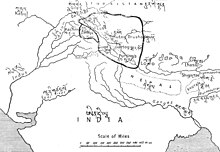 The empire of Kyide Nyimagon divided among his three sons, c. 930 CE. The border between Ladakh/Maryul and Guge-Purang is shown in a thin dotted line, north of Gartok
The empire of Kyide Nyimagon divided among his three sons, c. 930 CE. The border between Ladakh/Maryul and Guge-Purang is shown in a thin dotted line, north of Gartok Ladakh as one of the many provinces of Tibet
Ladakh as one of the many provinces of TibetIn the 9th century, Tibet's ruler Langdarma was assassinated and Tibet fragmented. Kyide Nyimagon, Langdarma's great-grandson, fled to West Tibet c. 900 CE, and founded a new West Tibetan kingdom at the heart of the old Zhangzhung, now called Ngari in the Tibetan language.
 Royal drinking scene at Alchi Monastery, Ladakh, c. 1200 CE. The king wears a decorated Qabā', of Turco-Persian style. It is similar to another royal scene at nearby Mangyu Monastery.[10]
Royal drinking scene at Alchi Monastery, Ladakh, c. 1200 CE. The king wears a decorated Qabā', of Turco-Persian style. It is similar to another royal scene at nearby Mangyu Monastery.[10]Nyimagon's eldest son, Lhachen Palgyigon, is believed to have conquered the regions to the north, including Ladakh and Rutog. After the death of Nyimagon, his kingdom was divided among his three sons, Palgyigon receiving Ladakh, Rutog, Thok Jalung and an area referred to as Demchok Karpo (a holy mountain near the present-day Demchok village). The second son received Guge–Purang (called "Ngari Korsum") and the third son received Zanskar and Spiti (to the southwest of Ladakh). This three-way division of Nyimagon's empire was recognised as historic and remembered in the chronicles of all the three regions as a founding narrative.
He gave to each of his sons a separate kingdom, viz., to the eldest Dpal-gyi-gon, Maryul of Mngah-ris, the inhabitants using black bows; ru-thogs [Rutog] of the east and the Gold-mine of Hgog [possibly Thok Jalung]; nearer this way Lde-mchog-dkar-po [Demchok Karpo]; ...
[citation needed]
The first West Tibetan dynasty of Maryul founded by Palgyigon lasted five centuries, being weakened towards its end by the conquests of the Mongol/Mughal noble Mirza Haidar Dughlat. Throughout this period the region was called "Maryul", possibly from the original proper name *Mrasa (Xuangzhang's, Mo-lo-so), but in the Tibetan language it was interpreted to mean "lowland" (the lowland of Ngari). Maryul remained staunchly Buddhist during this period, having participated in the second diffusion of Buddhism from India to Tibet via Kashmir and Zanskar.



 Jama Masjid of Leh next to the Leh Palace
Jama Masjid of Leh next to the Leh PalaceBetween the 1380s and early 1510s, many Islamic missionaries propagated Islam and proselytised the Ladakhi people. Sayyid Ali Hamadani, Sayyid Muhammad Nur Baksh and Mir Shamsuddin Iraqi were three important Sufi missionaries who propagated Islam to the locals. Mir Sayyid Ali was the first one to make Muslim converts in Ladakh and is often described as the founder of Islam in Ladakh. Several mosques were built in Ladakh during this period, including in Mulbhe, Padum and Shey, the capital of Ladakh.[11][12] His principal disciple, Sayyid Muhammad Nur Baksh also propagated Islam to Ladakhis and the Balti people rapidly converted to Islam. Noorbakshia Islam is named after him and his followers are only found in Baltistan and Ladakh. During his youth, Sultan Zain-ul-Abidin expelled the mystic Sheikh Zain Shahwalli for showing disrespect to him. The sheikh then went to Ladakh and proselytised many people to Islam. In 1505, Shamsuddin Iraqi, a noted Shia scholar, visited Kashmir and Baltistan. He helped in spreading Shia Islam in Kashmir and converted the overwhelming majority of Muslims in Baltistan to his school of thought.[12]
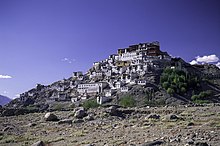 Thikse Monastery, Ladakh
Thikse Monastery, LadakhIt is unclear what happened to Islam after this period and it seems to have received a setback. Mirza Muhammad Haidar Dughlat who invaded and briefly conquered Ladakh in 1532, 1545 and 1548, does not record any presence of Islam in Leh during his invasion although Shia Islam and Noorbakshia Islam continued to flourish in other regions of Ladakh.[11][12]
King Bhagan reunited and strengthened Ladakh and founded the Namgyal dynasty (Namgyal means "victorious" in several Tibetan languages). The Namgyals repelled most Central Asian raiders and temporarily extended the kingdom as far as Nepal.[1] During the Balti invasion led by Raja Ali Sher Khan Anchan, many Buddhist temples and artefacts were damaged. Ali Sher Khan took the king and his soldiers as captives. Jamyang Namgyal was later restored to the throne by Ali Sher Khan and given the hand of a Muslim princess in marriage. Her name was Gyal Khatun or Argyal Khatoom. She was to be the first queen and her son was to become the next ruler. Historical accounts differ upon who her father was. Some identify Ali's ally and Raja of Khaplu Yabgo Shey Gilazi as her father, while others identify Ali himself as the father.[13][14][15][16][17][18] In the early 17th century efforts were made to restore the destroyed artefacts and gonpas by Sengge Namgyal, the son of Jamyang and Gyal. He expanded the kingdom into Zangskar and Spiti. Despite a defeat of Ladakh by the Mughals, who had already annexed Kashmir and Baltistan, Ladakh retained its independence.
 The empire of kings Tsewang Namgyal and Jamyang Namgyal, about 1560–1600 CE
The empire of kings Tsewang Namgyal and Jamyang Namgyal, about 1560–1600 CE Cham dance during Dosmoche festival in Leh Palace
Cham dance during Dosmoche festival in Leh PalaceIslam begins to take root in the Leh area in the beginning of the 17th century after the Balti invasion and the marriage of Gyal to Jamyang. A large group of Muslim servants and musicians were sent along with Gyal to Ladakh and private mosques were built where they could pray. The Muslim musicians later settled in Leh. Several hundred Baltis migrated to the kingdom and according to oral tradition many Muslim traders were granted land to settle. Many other Muslims were invited over the following years for various purposes.[19]
In the late 17th century, Ladakh sided with Bhutan in its dispute with Tibet which, among other reasons, resulted in its invasion by the Tibetan Central Government. This event is known as the Tibet–Ladakh–Mughal war of 1679–1684.[20] Kashmiri historians assert that the king converted to Islam in return for the assistance by Mughal Empire after this, however, Ladakhi chronicles do not mention such a thing. The king agreed to pay tribute to the Mughals in return for defending the kingdom.[21][22] The Mughals, however, withdrew after being paid off by the 5th Dalai Lama.[23] With the help of reinforcements from Galdan Boshugtu Khan, Khan of the Zungar Empire, the Tibetans attacked again in 1684. The Tibetans were victorious and concluded a treaty with Ladakh then they retreated back to Lhasa in December 1684. The Treaty of Tingmosgang in 1684 settled the dispute between Tibet and Ladakh but severely restricted Ladakh's independence.
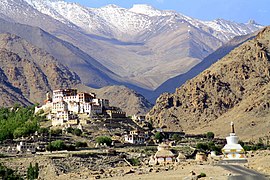


 The disputed territory of the princely state of Jammu and Kashmir: divided between Pakistan (green), India (blue) and China (yellow)
The disputed territory of the princely state of Jammu and Kashmir: divided between Pakistan (green), India (blue) and China (yellow)In 1834, the Sikh Zorawar Singh, a general of Raja Gulab Singh of Jammu, invaded and annexed Ladakh to Jammu under the suzerainty of the Sikh Empire. After the defeat of the Sikhs in the First Anglo-Sikh War, the state of Jammu and Kashmir was established as a separate princely state under British suzerainty. The Namgyal family was given the jagir of Stok, which it nominally retains to this day. European influence began in Ladakh in the 1850s and increased. Geologists, sportsmen, and tourists began exploring Ladakh. In 1885, Leh became the headquarters of a mission of the Moravian Church.
Ladakh was administered as a wazarat under Dogra rule, with a governor termed wazir-e-wazarat. It had three tehsils, based at Leh, Skardu and Kargil. The headquarters of the wazarat was at Leh for six months of the year and at Skardu for six months. When the legislative assembly, called Praja Sabha, was established in 1934, Ladakh was given two nominated seats in the assembly.
Ladakh was claimed as part of Tibet by Phuntsok Wangyal, a Tibetan Communist leader.[24]
Indian state of Jammu and KashmirAt the time of the partition of India in 1947, the Dogra ruler Maharaja Hari Singh chose to remain independent of India or Pakistan. Pakistani soldiers from Gilgit invaded in October and had reached Ladakh. To get defence assistance from India, Singh was told by Nehru to sign the Instrument of Accession to India, and military operations were initiated to counter the invasion. The wartime conversion of the pony trail from Sonamarg to Zoji La by army engineers permitted tanks to move up and successfully capture the pass. The advance continued. Dras, Kargil and Leh were liberated and Ladakh cleared of the infiltrators.[25]
In 1949, China closed the border between Nubra and Xinjiang, blocking old trade routes. In 1955 China began to build roads connecting Xinjiang and Tibet through the Aksai Chin area. The Indian effort to retain control of Aksai Chin led to the Sino-Indian War of 1962, which India lost. China also built the Karakoram highway jointly with Pakistan. India built the Srinagar-Leh Highway during this period, cutting the journey time between Srinagar and Leh from 16 days to two. The route, however, remains closed during the winter months due to heavy snowfall. Construction of a 6.5 km (4.0 mi) tunnel across Zoji La pass is under consideration to make the route functional throughout the year.[1][26]
 National Highway No 1
National Highway No 1The Kargil War of 1999, codenamed "Operation Vijay" by the Indian Army, saw infiltration by Pakistani troops into parts of Western Ladakh, namely Kargil, Dras, Mushkoh, Batalik and Chorbatla, overlooking key locations on the Srinagar-Leh highway. Extensive operations were launched in high altitudes by the Indian Army with considerable artillery and air force support. Pakistani troops were evicted from the Indian side of the Line of Control which the Indian government ordered was to be respected and which was not crossed by Indian troops. The Indian government was criticised by the Indian public because India respected geographical co-ordinates more than India's opponents: Pakistan and China.[27][page needed]
The Ladakh region was divided into the Kargil and Leh districts in 1979. In 1989, there were violent riots between Buddhists and Muslims. Following demands for autonomy from the Kashmiri-dominated state government, the Ladakh Autonomous Hill Development Council was created in the 1990s. Leh and Kargil districts now each have their own locally elected Hill Councils with some control over local policy and development funds. In 1991, a Peace Pagoda was erected in Leh by Nipponzan Myohoji.
There was a heavy presence of Indian Army and Indo-Tibetan Border Police forces in Ladakh. These forces and People's Liberation Army forces from China have, since the 1962 Sino-Indian War, had frequent stand-offs along the Ladakh portion of the Line of Actual Control. Out of the 857-kilometre-long (533 mi) border in Ladakh, only 368 km (229 mi) is the International Border, and the remaining 489 km (304 mi) is the Line of Actual Control.[28][29] The stand-off involving the most troops was in September 2014 in the disputed Chumar region when 800 to 1,000 Indian troops and 1,500 Chinese troops came into close proximity to each other.[30]
Ladakh DivisionOn 8 February 2019, Ladakh became a separate Revenue and Administrative Division within Jammu and Kashmir, having previously been part of the Kashmir Division. As a division, Ladakh was granted its own Divisional Commissioner and Inspector General of Police.[31]
Leh was initially chosen to be the headquarters of the new division however, following protests, it was announced that Leh and Kargil will jointly serve as the divisional headquarters, each hosting an Additional Divisional Commissioner to assist the Divisional Commissioner and Inspector General of Police who will spend half their time in each town.[32]
Union territory of Ladakh Ladakh (L) shown in the wider Kashmir region
Ladakh (L) shown in the wider Kashmir regionThe people of Ladakh had been demanding Ladakh to be constituted as a separate territory since 1930s, because of perceived unfair treatment by Kashmir and Ladakh's cultural differences with predominantly Muslim Kashmir valley, while some people in Kargil opposed union territory status for Ladakh.[1][33] The first organised agitation was launched against Kashmir's "dominance" in the year 1964. In late 1980s, a much larger mass agitation was launched to press their demand for union territory status.[34]
In August 2019, a reorganisation act was passed by the Parliament of India which contained provisions to reconstitute Ladakh as a union territory, separate from the rest of Jammu and Kashmir on 31 October 2019.[35][36][37][38] Under the terms of the act, the union territory is administered by a Lieutenant Governor acting on behalf of the Central Government of India and does not have an elected legislative assembly or chief minister. Each district within the union territory continues to elect an autonomous district council as done previously.[39]
The demand for Ladakh as separate union territory was first raised by the parliamentarian Kushok Bakula Rinpoche around 1955, which was later carried forward by another parliamentarian Thupstan Chhewang.[40] The former Jammu and Kashmir state use to obtain large allocation of annual funds from the union government based on the fact that the large geographical area of the Ladakh (comprising 65% of total area), but Ladakh was allocated only 2% of the state budget based on its relative population.[40] Within the first year of the formation of Ladakh as separate union territory, its annual budget allocation has increased 4 times from ₹57 crore to ₹232 crore.[40]


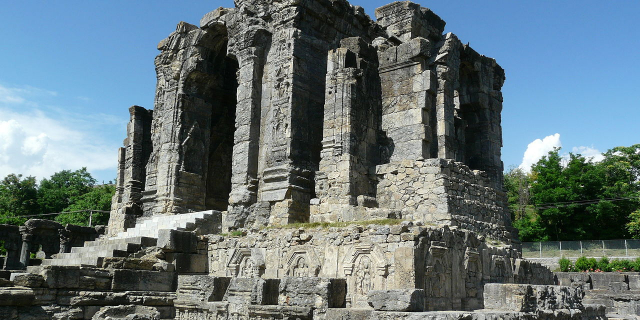









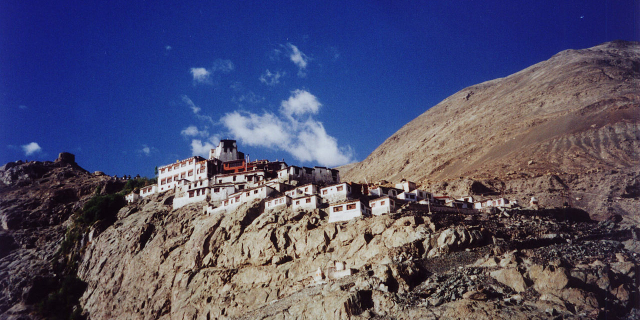







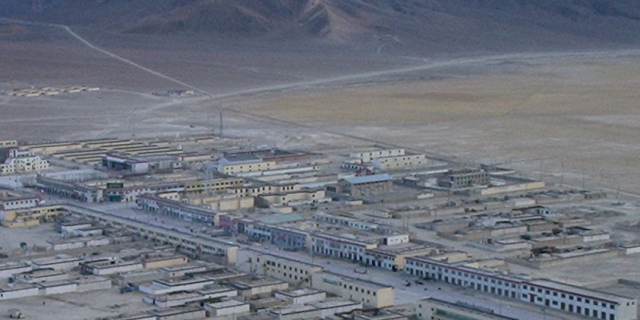








Add new comment